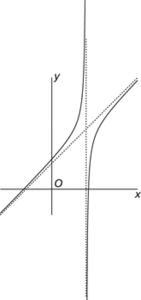A line that a curve approaches but only touches at infinity.
A line l is an asymptote to a curve if the distance from a point P to the line l tends to zero as P tends to infinity along some unbounded part of the curve. Consider the following examples:
Example (i) has x =−2 and x =1 as vertical asymptotes and y = 0 as a horizontal asymptote. Example (ii) has no vertical asymptotes and y = 3 as a horizontal asymptote. To investigate example (iii), it can be rewritten as
Then it can be seen that y = x−1 is a slant (or oblique) asymptote, that is, an asymptote that is neither vertical nor horizontal.
If part of a graph is unbounded and there is a fixed straight line l such that the distance from a point P on the graph to l tends to 0 as OP → ∞, where O is the origin, then l is an asymptote to the curve. Alternatively, it is the limiting position of the tangent to the graph at P, as OP → ∞. For example, the asymptotes of the graph of
 are y=2x+3 and x=2.
are y=2x+3 and x=2.
Asymptote. The dotted lines are the asymptotes (vertical, x=2; oblique, y=2x+3) of the graph y=2x+3−.
A straight line that is closely approached by a curve so that the perpendicular distance between them decreases to zero at an infinite distance from the origin.
- pseudo modus ponens
- pseudomorph
- pseudonodule
- pseudonoise sequence
- pseudonymous record
- pseudo-operation
- pseudo order
- pseudo-order
- pseudoparenchyma
- pseudoplasmodium
- pseudoplastic
- pseudopodium
- pseudopregnancy
- pseudoprime
- pseudopunctate
- pseudorandom
- pseudo-random numbers
- pseudorandom numbers
- pseudo-scalar
- pseudosection
- pseudospar
- pseudo-statement
- Pseudosycidium
- pseudotachylite
- pseudovalue